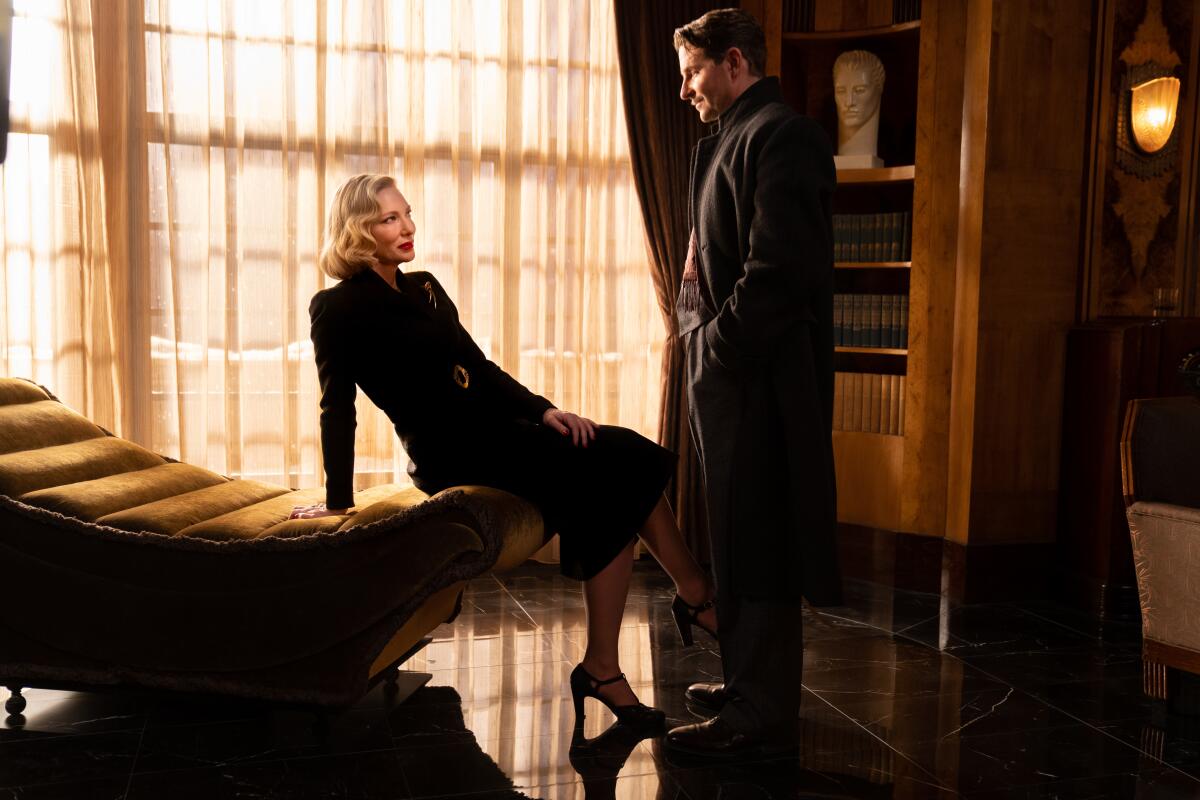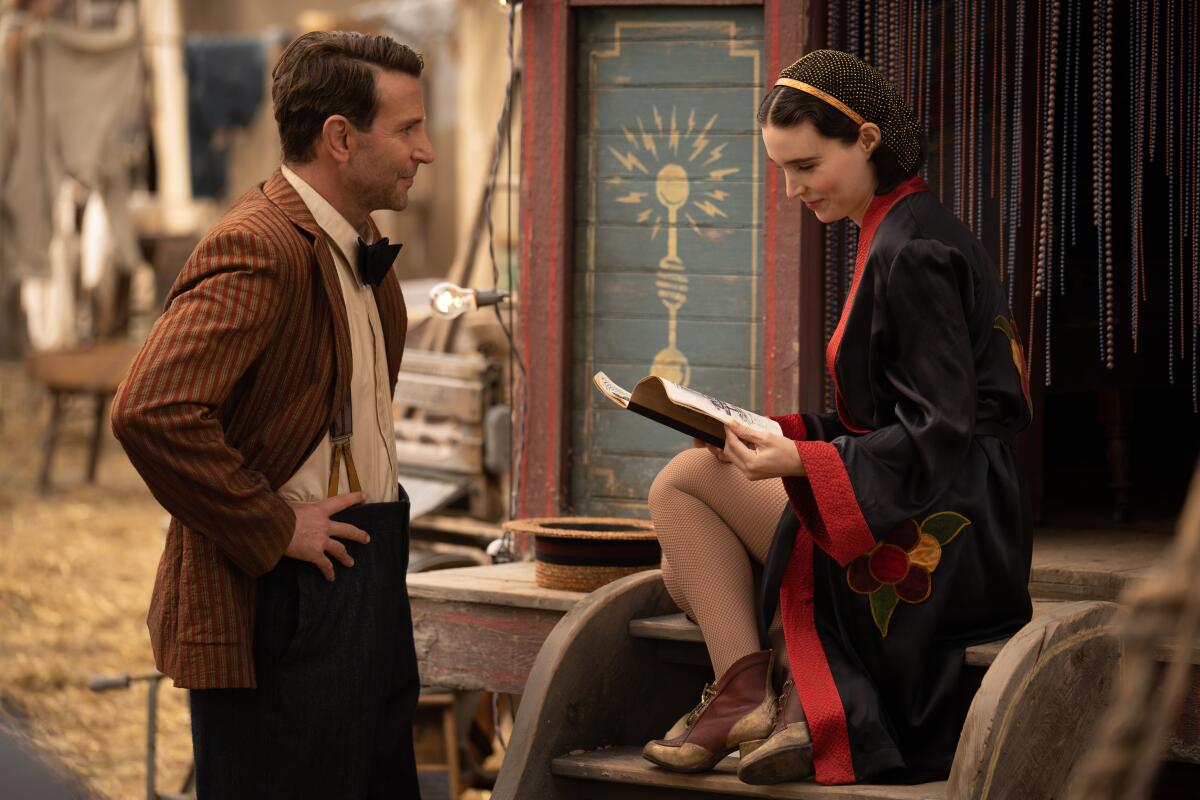Review: Bradley Cooper illuminates the dazzling noir shadows of ‘Nightmare Alley’

- Share via
The Times is committed to reviewing theatrical film releases during the COVID-19 pandemic. Because moviegoing carries risks during this time, we remind readers to follow health and safety guidelines as outlined by the Centers for Disease Control and Prevention and local health officials.
There’s always been something faintly unsettled about Bradley Cooper — not unsettling, necessarily, but unsettled, as if he didn’t entirely belong in his own skin. Handsome as the devil and about as trustworthy, his most memorable characters wear their good looks like a mask that keeps slipping, almost but not quite concealing some underlying disturbance. It’s what made him such a haunted soldier in “American Sniper” and lent such tragic force to his downfall in “A Star Is Born.” Cooper directed, as well as starred, in that picture and in doing so demonstrated a keen understanding of his own presence, with its unique ability to command and trouble the screen.
As evidenced by the spectacularly grim neo-noir “Nightmare Alley,” the writer-director Guillermo del Toro understands it too. In this adaptation of William Lindsay Gresham’s 1946 novel (it was previously filmed in 1947, with an excellent Tyrone Power in the lead), Cooper plays Stanton Carlisle, a man of lowly roots, high ambitions and a dark past that we see going up in flames in the opening scenes. It’s immediately clear that Stanton’s no good. But Cooper’s moody, chilly beauty — to say nothing of the movie’s — keeps us glued as he strides away from the smoky ruin and makes his way by bus to a traveling carnival, where the local impresario, Clem Hoatley (Willem Dafoe), sizes him up and gives him a job.
The year is 1939, and Stanton is our guide to this rain-soaked amusement park, a source of cheap thrills for Americans during the recent Depression years and a rich repository of wonderment for a 21st century movie audience. Intricately designed by Tamara Deverell and fully inhabited by Dan Laustsen’s gliding, prowling camera, the carnival springs to life here as a fully realized world. Its attractions are classically familiar — a carousel, a Ferris wheel, a dwarf, a bearded lady — and also cinematically enveloping. When a performer like Molly (Rooney Mara) channels electricity with her fingertips, or when Zeena (Toni Collette) delivers a virtuosic display of mind reading, we aren’t just witnessing a bygone form of live entertainment. We’re reminded that cinema — call it movie magic — is itself an advanced form of charlatanism, a sustained illusion that leaves us wondering, “How’d they do that?”
Stanton soon discovers some of the answers to that question. Eager to learn the tricks of the carny trade, he also proves ominously willing to push past its ethical boundaries. He covets the little black book safeguarded by Zeena’s alcoholic husband, Pete (a lovable David Strathairn), which contains the secret verbal cues they use in their mentalism act. At various points, he presses Clem about how one goes about hiring a geek — and by geek, I mean a wailing circus performer who bites the heads off live chickens, rather than, say, a cinephile with Del Toro’s particular appetite for classic horror and science fiction.

“Nightmare Alley,” which Del Toro co-wrote with the brilliant film critic and noir aficionado Kim Morgan, opens up a fresh lane in the director’s genre scholarship. It’s a film noir in much the same way that “Crimson Peak” was a horror movie: Feverishly and often magnificently overwrought, it treats its genre less as a template to be followed than a lavish funhouse in which to run amok. Its characters, tropes and archetypes, convincing enough on their own, take on even richer dimensions when placed alongside their antecedents. To watch Cooper’s ill-fated antihero — or, in due course, Cate Blanchett’s spectacularly malevolent femme fatale — is to see an entire cinematic history distilled into something rich, singular and knowing.
And Del Toro, in seeking to master this new direction, has set himself a fascinating challenge. There’s something particularly intriguing about watching a filmmaker so comfortable with supernatural phenomena set out to deconstruct them. The existence of real magic, of forces that defy the laws of science and the limits of the imagination, has never been an obstacle for the Mexican-born fantasist behind “The Devil’s Backbone,” “Pan’s Labyrinth” and “The Shape of Water.” In those movies, otherworldly forces always carry a fiercely political dimension: They are less a source of evil than a weapon against it, empowering people of good faith to stand against brutal totalitarian regimes.
The magic in “Nightmare Alley,” by contrast, is little more than cheap trickery, though it becomes rather more lucrative once Stanton and Molly run off to the big city and launch their own mind-reading act for the entertainment of posh supper-club crowds. And while a war against fascism is again playing out in the background — the story begins in 1939 but soon leaps ahead to 1941 — its moral implications couldn’t be more lost on Stanton, who, apart from his conditional love for Molly (every magician needs an assistant), cares for no one and nothing other than himself. And his deviousness lies in his ability to seem precisely the opposite, to seem wise and empathetic as he connects his clients (or marks, as he calls them) with the ghosts of their late loved ones.
This spiritualist charade is managed with a crucial assist from Lilith Ritter (Blanchett), a distinguished psychologist who proves all too willing to sell out her wealthiest clients to Stanton. A vision with her creamy pallor, her immaculately coiffed hair — a little Veronica Lake, a little Barbara Stanwyck — and a blood-red slab of a mouth that was made to dispense double entendres, Blanchett gives the movie a lurid jolt of energy. She proves both a formidable nemesis to Stanton and a highly untrustworthy ally, and the story’s most revealing scenes play out in her opulent private office — a fabulous Art Deco stage where she nudges Stanton and the movie to ever more devious levels of gamesmanship.
What happens behind these wood-paneled sliding doors is a riveting extension of Stanton’s theatrical mind tricks. This time, the live audience has vanished, and both Stanton and Lilith are clearly performing, each one trying to read the other. You can glean a lot just from the way Del Toro directs both actors: the way Blanchett’s Lilith slinks around the scenery, like a cat that has laid claim to every surface, while Cooper’s Stanton remains wary and reined in, as if reluctant to get too comfortable. And you can’t help but savor the uneasy, asymmetrical partnership that emerges between them, right down to the uncanny way they sometimes seem to exchange roles.
Stanton’s act turns him into a kind of therapist, an emotional counselor for his marks, as well as a spiritual conduit. And Lilith’s ostensibly more professional practice entails its own measure of performative artifice, especially when she begins granting Stanton access to the skeletons inside her former clients’ closets. (The two most important ones are played, briefly but piercingly, by Richard Jenkins and Mary Steenburgen.)
Both psychology and mentalism call for a level of heightened discernment, a Sherlock Holmes-ian ability to decipher the meaning of clothing, behavior and body language. The ability to read character through verbal and visual clues is, of course, a useful tool when it comes to movie watching, and in “Nightmare Alley,” Del Toro dares us to not only read Stanton Carlisle’s mind but also to peer into the void where his soul should be. His ambition is the result of insatiable greed, but also something more: a sense of pride, a desperate need to prove that he’s as extraordinary as he claims. To say that his downward spiral feels inevitable, even circumscribed, is to quibble less with the character than the fatalistic rules of the genre to which the movie belongs.
At a leisurely two-and-a-half hours, “Nightmare Alley” doesn’t have the propulsive energy and razor-sharp economy of the ’40s noirs it’s channeling, its 1947 predecessor included. But it cuts like a razor anyway, sometimes quite literally: As usual with Del Toro, there are moments of extraordinary violence that sometimes threaten to tilt into sadism. His love of mangled appendages and smashed-in faces has lost none of its splattery ardor. But if these bloody eruptions are delivered with a grotesque flourish, they are also a logical consequence, an outgrowth of the story Del Toro’s telling and the world he’s exploring.
And it would be hard to imagine a more memorable guide to that world than Cooper, whose broodingly dark, increasingly frenzied performance captures nothing less than the realization — and putrefaction — of one man’s American dream. He undergoes an astonishing transformation, one that inspires attraction, revulsion, pity and, most disquietingly, a spasm of recognition. By rights, Stanton Carlisle should be forgotten, but just try getting him out of your mind.
‘Nightmare Alley’
Rating: R, for strong/bloody violence, some sexual content, nudity and language
Running time: 2 hours, 30 minutes
Playing: Starts Dec. 17 in general release
More to Read
Only good movies
Get the Indie Focus newsletter, Mark Olsen's weekly guide to the world of cinema.
You may occasionally receive promotional content from the Los Angeles Times.








